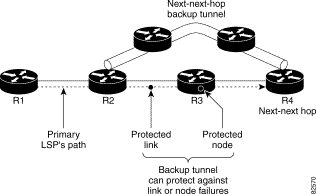|
|

Cisco MPLS Tunnel Builder is a web-based graphical application for configuring and visualizing Multiprotocol Label Switching (MPLS) tunnels. It can also be used for viewing performance statistics using the Service Assurance Agent (SAA) on supported Cisco IOS platforms.
Tunnel Builder Pro adds the capability of recommending Fast Reroute (FRR) backup tunnel placement to guarantee bandwidth protection.
 |
Note Throughout this manual, concepts such as guaranteed bandwidth, load balancing, and so forth, are described in the applicable chapters. |
This chapter contains the following sections:
Tunnel Builder Pro features include the following:
Tunnel Builder Pro provides bandwidth protection for both links and nodes through the use of FRR backup tunnels. A backup tunnel is an MPLS TE tunnel used to protect other (primary) tunnels' traffic when a link or node failure occurs.
There are two types of backup tunnels:
Links may or may not be part of an SRLG.
 |
Note If the endpoint of a protected link has a backup tunnel configured that ends three hops away, it is called a next-next-next-hop (NNNH) backup tunnel. That type of backup tunnel is not used by Cisco IOS and it is not considered by the Tunnel Builder Pro algorithm. Tunnel Builder Pro ignores NNNH backup tunnels; it does not issue warning or violation messages. |
Backup tunnels that bypass only a single link of a primary Label Switched Path's (LSPs) path protect LSPs if a link fails by rerouting the LSP's traffic to the next hop (bypassing the failed link). These are referred to as next-hop (NHOP) backup tunnels because they terminate at the next hop of the LSP's path after the point of failure.
To provide link protection, Tunnel Builder Pro uses NHOP backup tunnels for LSPs terminating at the far end of a link. For LSPs terminating beyond that, Tunnel Builder Pro uses the following:
Figure 1-1 illustrates an NHOP backup tunnel.

Tunnel Builder Pro provides node protection for LSPs. Backup tunnels that bypass next-hop nodes along LSPs are called next-next-hop (NNHOP) backup tunnels because they terminate at the node following the next-hop node of the LSPs, thereby bypassing the next-hop node. They protect LSPs by enabling the node upstream of a link or node failure to reroute the LSPs and their traffic around the failure to the next-next-hop.
Figure 1-2 illustrates an NNHOP backup tunnel.

 |
Note NHOP and NNHOP backup tunnels are typically activated much faster than the time it takes for signaling to notify the head end of each primary tunnel that an element failure has occurred. When an FRR backup tunnel is activated, it is only used until the head end of each primary tunnel receives notification of a failure and can resignal a new end-to-end path for the primary tunnel. |
Benefits include the following:
Tunnel Builder Pro is an enhancement to Tunnel Builder. Tunnel Builder Version 2.0 has the following features that are also incorporated into Tunnel Builder Pro:
Tunnel Builder Pro displays a network map on the right side of the browser window. The map displays all nodes and interfaces on which MPLS TE is enabled. It can also display MPLS TE tunnels overlaid on this topology. Both primary and FRR backup tunnels can be displayed.
Tunnel Builder Pro does the following:
For more detailed information, see "Viewing and Modifying TE Parameters."
Tunnel Builder Pro does the following:
For more detailed information, see "Viewing and Modifying TE Parameters."
Tunnel Builder Pro does the following:
For more detailed information, see "Managing Primary Tunnels."
Access to your router is secure. For more information, see "Using Tunnel Builder Pro for the First Time."
The Tunnel Builder Pro online help system uses your default web browser. Supported browsers are Netscape Navigator (Version 4.7 or later) and Internet Explorer (Version 5.5 or later).
After installing Tunnel Builder Pro and fetching your network data, the following appears in the browser window:
For a detailed explanation, see "Network Map", and "Using Tunnel Builder Pro for the First Time."
Click one of the following tabs:
 |
Note If you scroll so that a message is not displayed, and then a new message is displayed, you cannot read the new message unless you scroll up. |
![]()
![]()
![]()
![]()
![]()
![]()
![]()
![]()
Posted: Fri Oct 11 11:07:09 PDT 2002
All contents are Copyright © 1992--2002 Cisco Systems, Inc. All rights reserved.
Important Notices and Privacy Statement.